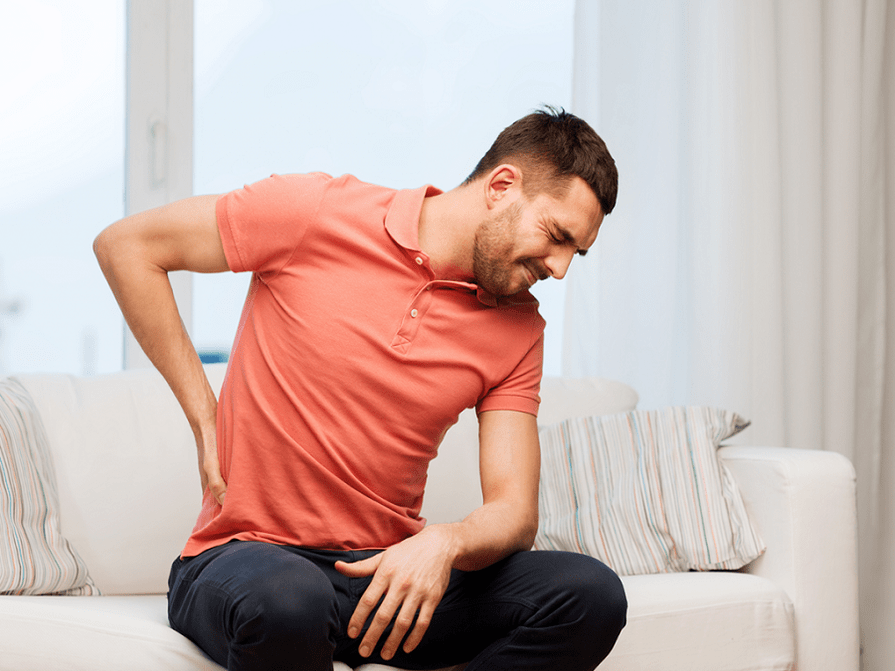
Low back pain can be linked to a variety of causes - for example, muscle damage, bowel pathology, bulging, and herniated disc. It is impossible to determine the exact cause yourself. Therefore, if there are discomforts, it is necessary to undergo a diagnosis and follow the recommendations of the doctor. In most cases, drugs and procedures are used to treat it. But surgery may also be necessary.
The lower back hurts: reasons
Lower back pain can be associated with the spine, muscles, nervous system, and other systems. The most common reasons are:
- Traumatic injuries to the lumbar spine or other parts of the spine.
- Damage to muscle tissue or severe tension.
- Hernia, bulging.
- Curvature.
- Neuropathy
- Inflammatory processes of the vertebral tissue.
- Pinched nerve.
- Pathologies of the intestines, stomach, liver and other digestive organs (in this case, pain in the lumbar area is also caused).
- Poisoning, intoxication.
- Pathologies of the excretory system - kidney failure, pyelonephritis, cystitis, kidney stones, ureters.
- Diseases of the uterus - cyst, fibroids, inflammatory processes.
What to do when your lower back hurts
It is impossible to reliably determine the source of pain at home. It is therefore recommended that you consult a doctor if you feel unfamiliar. If diagnosed early, treatment is effective and quick. You need to contact such specialists:
- Surgeon or Traumatologist - if pain is associated with newer herbs, including sports or household herbs.
- Neurologist - painful sensations of an acute, shooting character. May be accompanied by sensitivity problems in the legs and loss of mobility. Symptoms such as goose bumps on the surface of the abdomen or on the legs are also observed.
- Gastroenterologist - long drawing pain mainly on one side of the lumbar region. Also, the sensations can be painful, accompanied by too frequent or difficult urination.
- Gynecologist - in this case, pain is observed from both one and two sides. In addition, they are accompanied by weakness, which is aggravated while walking and running, during menstruation, and also during pregnancy.
On rare occasions, when the cause of the pain is objectively clear, you shouldn't worry. So if strange sensations are associated with a long stay in one position and physical activity, there is no need to see a doctor. However, if the pain does not go away for several days or is acute, it is necessary to make an appointment as soon as possible and undergo a diagnosis.
Lower back pain: diagnosis
The diagnosis is prescribed by a doctor after an examination, examination of the symptoms and anamnesis. The need for a particular procedure depends on what symptoms accompany the pain:
- Spine x-ray - hernias, protrusions, back injuries, posture problems.
- MRI of the lower back - for hernias, curvatures, injuries, as well as suspected neoplasms.
- CT scan of the lower back - the same indications as for MRI.
- Ultrasound - suspected pathology of the intestines and other organs in the abdominal cavity.
- Colonoscopy, gastroscopy - these studies are carried out when diseases of the gastrointestinal tract are suspected. The doctor not only examines the organs, but can also take a tissue sample (biopsy) for further research.
- An intestinal MRI is done to examine the gastrointestinal tract more closely to confirm or verify a previously made diagnosis.
Treatment methods
Methods, duration and treatment regimen are determined by the doctor depending on the diagnosis. In most cases, drugs are indicated, such as non-steroidal anti-inflammatory drugs. It is also possible to take part in massage sessions and perform physiotherapy procedures.
If the diagnosis involves only surgical treatment, surgery is done. This is necessary, for example, with hernias, gastric ulcers and other pathologies.
Prevent back pain
Lower back pain can be linked to work conditions and lifestyle. The main physical activity falls on the lumbar spine. This is especially dangerous if you are constantly lifting weights, exercising, or have household injuries.
For prevention it is recommended:
- Do sports regularly.
- If work is combined with physical labor, you will learn to lift weights properly and not to overload your back.
- If work involves sitting for a long time, get up regularly, walk, change your posture.
- Avoid hypothermia of the back, dress appropriately for the weather.
- Keep your back straight when sitting and in the posture.
- Eat a balanced diet.
- Do not abuse alcohol, smoking, or other bad habits.
If the pain occurs more frequently and especially if it is acute, you should consult a doctor immediately. It's important to understand that treatment often lasts several months, especially when you're recovering from surgery. In this case, it is worthwhile to adapt your lifestyle and, if necessary, to change jobs.





































